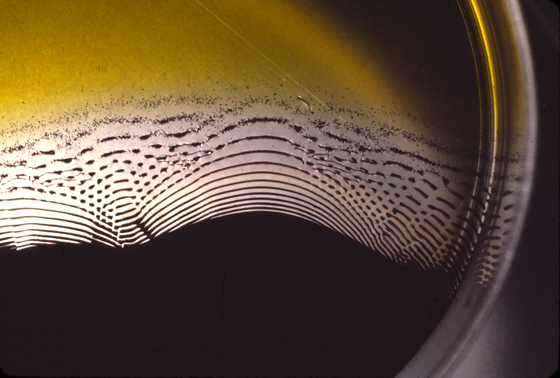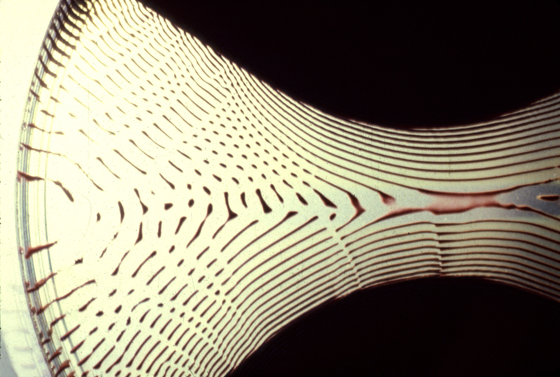January 16th lecture
Embryology Biology 441 Spring 2008 Albert Harris
Reaction-Diffusion Systems = "The Turing Model"
Close range stimulaton + Longer-range inhibition.
The hypothetical chemicals "A & B" could be any quantitative variables.
Assumptions the textbook and almost everyone assumes:
-
1) That gradients are diffusion gradients of particular chemicals.
2) That cell differentiation is controlled by individual chemicals.
3) That only the set of equations proposed by Turing, or ones very similar to them can cause regular spatial patterns to form.
I) Other kinds of gradients are possible:
any property that averages itself out between neighbors.
II) There is evidence that mechanical tensions in the future central nervous system ("The neural plate" during neurulation) is a key part in what signals those cells to differentiate as nerves;
And packing density of future limb cells helps decide which will as cartilage skeleton.
BUT I DON'T WANT TO KID YOU, 99% OF RESEARCHERS TODAY BELIEVE ALL SUCH SIGNALS ARE CHEMICALS.
III) Several very different combinations of chemical reactions also produce regular spatial patterns, some like zebra stripes.
For example, if you make gelatin with potassium chromate (!very poisonous!) dissolved in it, and then put silver nitrate crystals on the gel, then silver chromate salt will precipitate in ring-like or band-like patterns.
These are called "Liesegang Rings" and were discovered in photography experiments in the 1890s, and nobody has yet discovered the mechanism that causes gaps between the rings. (1000s of research papers written on this!)


-
time lapse video of Liesegang rings forming
The main question for today:
If you separate the first two cells of a sea urchin embryo at the two cell stage, then each of the two can develop into a half-size embryo, with all parts proportionally small.At the 4 cell stage, you can separate all 4 cells, and each can develop into a quarter-sized larva.
This phenomenon was discovered by Hans Driesch in the 1890s, using starfish eggs in Naples.

Phenomena like this are called "Regulation" or "Embryonic Regulation"
Note that this word could be misleading, and imply some kind of external control, like by a government regulatory agency.
Another example of embryonic regulation:
You can put two early embryos next to each other,
So that they fuse, and develop into one animal.
The embryos don't need to be the same species!
Mouse-Rat chimeras have been made, and they live.
Sheep-Goat chimeras also develop fine.
Similar fusions were done first with salamanders
of different species, and different sizes.
No one has or will try this with human embryos and other mammal species, but the animal could probably develop and live.
(Incidentally, the immune system treats all molecules present during embryonic development as "self".)
Mammals and echinoderms have very regulative development.
Dictyostelium slime mold "slugs" are even more regulative.
Amphibians (frogs and salamanders) are not as regulative.
Snail, clam and sea squirt embryos are known for having very non-regulative development, and very consistent "cell lineages" (these lineages were discovered by Conklin at Woods Hole in the later 1800s and early 1900s).
If you separate the first 2 or the first 4 cells of their embryos then each develops into just part of the body.
Non-regulative development is called "Mosaic" development. One says that mollusks and sea squirts have mosaic development.
The kinds of animals whose development is most extremely mosaic are nematode worms (C. elegans) and flies like Drosophila. This was one of the main reasons that Brenner chose C. elegans as a model organism (and won a Nobel Prize for this).
Each nematode worm of a given species has exactly the same number of cells, and so does each organ. (although some mutations change these numbers).
Sulston shared the Nobel prize for determining the exact cell lineage of C. elegans, which he published in the journal Developmental Biology.
*******************************************************************
QUESTION FOR CLASS DISCUSSION:
What does regulation tell you about the basic control mechanisms of development? What does it tell you about mechanisms of development that embryos of many species (including mammals) can be separated into 1/2 or 1/4, and still develop normally?